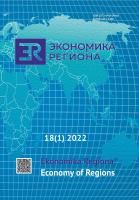Patterns of Added Value and Innovation in Europe — With Special Regards to Metropolitan Regions of CEE
Patterns of Added Value and Innovation in Europe — With Special Regards to Metropolitan Regions of CEE
Author(s): Dóra SzendiSubject(s): Economy, National Economy, Supranational / Global Economy, International relations/trade, EU-Approach / EU-Accession / EU-Development
Published by: Институт экономики Уральского отделения Российской академии наук
Keywords: spatial econometrics; spatial autocorrelation; metropolitan regions; Central and Eastern Europe; inequalities; gross value added; innovation; patent applications; European Union; NUTS3;
Summary/Abstract: The increasing territorial inequalities are raising a huge challenge for the European Union. There are significant differences among the given parts of Europe in terms of gross domestic product (GDP) per capita. Innovation and added value are also important indicators of regional economic development, and competitiveness. For example, improving innovation performance can enhance the national competitiveness. This research analyses the patterns of gross value added (GVA) and innovation (with special regards to the patent applications) in the European NUTS3 (county level) regions. The aim is to identify the major tendencies of concentration in the European spatial structure and to see the trends of change in the indicators. Metropolitan regions were analysed as special areas. The research question was whether the values of gross value added and the patent applications are concentrating in metropolitan areas, or there are significant hot spots outside them. It is hypothesised that because of the concentration of capital, most patent applications are also concentrated in the metropolitan areas of Europe. This hypothesis was tested using spatial econometric methods. The results show that the metropolitan regions have a significant contribution to GVA and patent applications of the European Union. In 2015, 65.7 % of all GVA and 57.1 % of all patent applications were concentrating in the metropolitan regions of Europe. The spatial autocorrelation is a significant factor in the case of both indicators. The complex (economic and innovation) index shows great Western-eastern, Northern-southern differences, the best position of South Germany, and the peripheral situation of CEE (Central and Eastern Europe) metro regions. Basic shortcomings/limitations of research can be found in the innovation data, as the number of patent applications is not published every year.
Journal: Экономика региона
- Issue Year: 18/2022
- Issue No: 1
- Page Range: 252-264
- Page Count: 13
- Language: English

